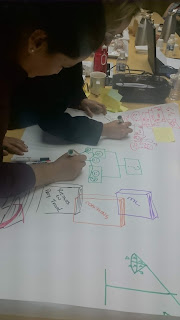What is Work Expo?
As expositions and museums they tell stories with pictures or objects. They inspire people by showing both the beautiful and the terrible things that have shaped humanity into what it is now. Some things we hope to create more of in the future, while other things we hope to never witness again.
What I learned?
Expositions and museums are popular because they tell stories with pictures or objects. They inspire people by showing both the beautiful and the terrible things that have shaped humanity into what it is now. Management 3.0 Workout - Chapter Work Expo.
Work Expo is the metaphor of making and showing exhibitions in a fun collaborative way to create visual messages of the values of the team, the reason for being as a team and anchoring it in the minds and spirit of our collaborators.
As expositions and museums they tell stories with pictures or objects. They inspire people by showing both the beautiful and the terrible things that have shaped humanity into what it is now. Some things we hope to create more of in the future, while other things we hope to never witness again.
Dowden, A Picture is Worth 1000 Words
Preparation:
- In slides or cards show key questions, for example:
- What is the purpose of the project, phase or sprint, etc, for the team?
- What are your favourite stories about the project, phase or sprint (good and bad ones), (What did we do well?, What did we do wrong?
- Coffe breaks (optional).
- Think about the purpose of your team and your work for the project, phase or sprint and take notes (10 minutes).
- In groups 3 people: Collect all the favourite stories that you like to tell about the project or sprint (the good ones and the bad ones) and note the keywords down (10 minutes).
- Decide which of the stories are the best examples of what you want or don’t want to happen in the future (8 minutes).
- Draw their stories to and build up the exposition (20 minutes).
- Every group presents their exposition – one after the other. The other people listen and ask questions. (15 minutes)
All together: Evaluate the things shown and discuss your common purpose (15 minutes).The Team presents its Work Expo

 |
| Others examples of Work Expo in sprint retrospective |
 |
| Find a wall and fill it with mementos from the past that serve as an example of the future. |
- Easy way to identify the purpose.
- You have to draw, activate the creativity of the team
- A good starting point for discussions and to define actions for the future,
- Lot's of fun and easy make.
- Keeps the team focussed on purpose.
When to use it?
- In retrospectives
- Team Coaching
More details about Work Expo:


Comentarios
Publicar un comentario